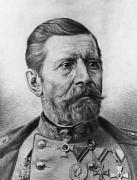Uchatius procedure
The Uchatius process is a method of steel production developed in the 19th century by the Austrian Lieutenant Field Marshal Franz von Uchatius .
history
Around the middle of the 19th century, the demand for cast steel increased sharply due to the economic development . The forms of steel production in use up to that point could not deliver the required large quantities, as steel was still produced in a very complicated way using bar irons , which was very laborious and expensive. The then captain Franz von Uchatius , an Austrian artillery officer, presented a new type of steel production to the public in 1856, in which large quantities of steel could be produced much more cheaply. He had worked on the problem for a total of eleven years. The steel obtained by this method was of very good quality and could be used in many ways. Uchatius applied for patents for his invention in many countries and for some time it seemed as if the Uchatius process would experience a major international breakthrough. However, at around the same time, the Briton Henry Bessemer had developed his process that could produce cheaper steel using the famous Bessemer pear . Very controversial at first, Bessemer eventually won the race and the Uchatius process did not prevail. Only in Sweden was very good quality steel made using the Uchatius process for decades.
Uchatius also developed hard or steel bronze for the casting of guns, so that expensive steel could be replaced. Like any bronze, this material has nothing to do with steel or the Uchatius process.
method
In this method, molten pig iron was poured into water and turned into granules by stirring . Then there were various surcharges such as brown iron stone . These granules were finally freed from carbon at high temperatures with the addition of a great deal of oxygen .
literature
- Helmut Neuhold: Competition for Krupp: the life of Franz Freiherrn von Uchatius . Öbv & Hpt, Vienna 2004, ISBN 3-209-04522-4 .
- Constantin von Wurzbach : Uchatius, Franz Freiherr . In: Biographisches Lexikon des Kaiserthums Oesterreich . 48th part. Kaiserlich-Königliche Hof- und Staatsdruckerei, Vienna 1883, pp. 209–213 ( digitized version ).
